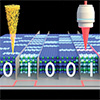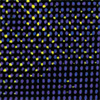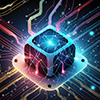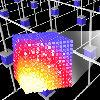Showing Spotlights 1 - 8 of 43 in category All (newest first):
 Researchers create fully memristive neuromorphic chip integrating trainable dendritic neurons and high-density RRAM, enabling energy-efficient brain-inspired computing architectures.
Researchers create fully memristive neuromorphic chip integrating trainable dendritic neurons and high-density RRAM, enabling energy-efficient brain-inspired computing architectures.
May 24th, 2024
 Researchers have developed a novel photochromic material that exhibits high-contrast luminescence switching. This material enables optical data storage with enhanced density and multilevel security using an innovative rotary encoder design.
Researchers have developed a novel photochromic material that exhibits high-contrast luminescence switching. This material enables optical data storage with enhanced density and multilevel security using an innovative rotary encoder design.
May 14th, 2024
 Novel data storage approach using atomic-scale defects in silicon carbide could enable high-density data archiving for over a million years, far surpassing current methods.
Novel data storage approach using atomic-scale defects in silicon carbide could enable high-density data archiving for over a million years, far surpassing current methods.
Apr 3rd, 2024
 A trailblazing metasurface computer architecture solves intricate matrix equations orders of magnitude faster than conventional processors by performing complex math intrinsically using scattered light waves.
A trailblazing metasurface computer architecture solves intricate matrix equations orders of magnitude faster than conventional processors by performing complex math intrinsically using scattered light waves.
Jan 12th, 2024
 Researchers developed resistive random access memory using high-entropy oxides, advancing memory devices with improved performance, efficiency and reliability.
Researchers developed resistive random access memory using high-entropy oxides, advancing memory devices with improved performance, efficiency and reliability.
Oct 18th, 2023
 Researchers have created an artificial synapse device that displays plasticity and learning ability by merging a photoelectric perovskite material with an organic ferroelectric polymer. The advance offers a pathway to intelligent electronics and insights into the brain.
Researchers have created an artificial synapse device that displays plasticity and learning ability by merging a photoelectric perovskite material with an organic ferroelectric polymer. The advance offers a pathway to intelligent electronics and insights into the brain.
Oct 11th, 2023
 Discover how researchers use self-rolling ferroic oxide films to revolutionize data storage. This innovative method increases storage density by up to 45 times, potentially achieving ultrahigh-density information storage of 10 Tbit per square inch, paving the way for next-gen memory technology.
Discover how researchers use self-rolling ferroic oxide films to revolutionize data storage. This innovative method increases storage density by up to 45 times, potentially achieving ultrahigh-density information storage of 10 Tbit per square inch, paving the way for next-gen memory technology.
May 15th, 2023
 Phase change memory is an emerging technology with great potential for advancing analog in-memory computing, particularly in deep neural networks and neuromorphic computing.
Phase change memory is an emerging technology with great potential for advancing analog in-memory computing, particularly in deep neural networks and neuromorphic computing.
Apr 14th, 2023
 Researchers create fully memristive neuromorphic chip integrating trainable dendritic neurons and high-density RRAM, enabling energy-efficient brain-inspired computing architectures.
Researchers create fully memristive neuromorphic chip integrating trainable dendritic neurons and high-density RRAM, enabling energy-efficient brain-inspired computing architectures.
 Subscribe to our Nanotechnology Spotlight feed
Subscribe to our Nanotechnology Spotlight feed





